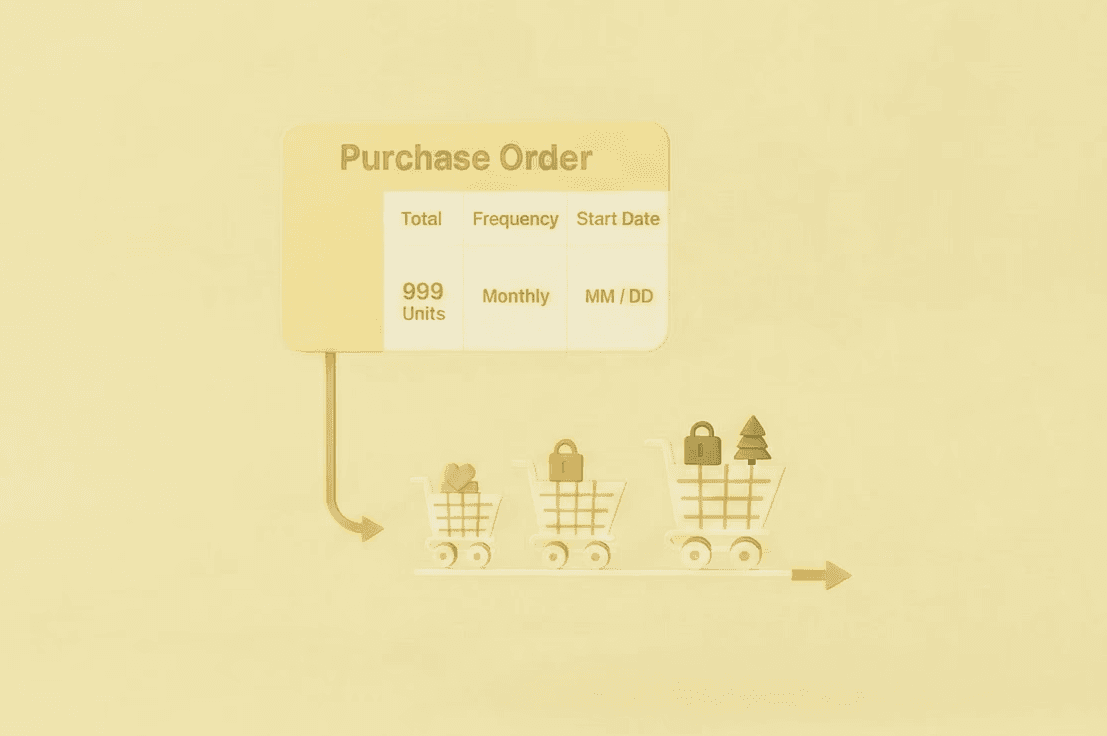Blog
Educational
How to Choose the Best Shopify Inventory Planning Tool for Multi‑Location Growth
How to Choose the Best Shopify Inventory Planning Tool for Multi‑Location Growth
Laura B
Marketing Analyst
Oct 16, 2025
The best Shopify inventory planning tool for multi-location growth is one that’s natively multi-location, forecasts per location with explainable drivers, ranks what to buy next by revenue impact and budget, automates supplier POs (respecting MOQs/case packs/price breaks), recommends transfers, and feeds carts with PO-driven ETA windows so customers see honest “Ships by –” dates.
Why this matters
When you run everything out of one stockroom, a simple “storewide” forecast can feel okay. But the second you add another node—a regional DC, a flagship store that ships locally, or a 3PL—your world changes. Shopify itself treats a location as any place (or app) where you sell, stock, or fulfill. That could be a retail store, a warehouse, a drop-ship partner, a popup, or a fulfillment app. Because Shopify tracks inventory separately for each of those places, your planning tool has to work the same way—or you’ll over-promise in one city, oversell in another, and spend Fridays triaging angry tickets.
Modern selling also means multiple channels. The sale that happens at your POS in a store, or on a marketplace like Amazon, needs to reduce available inventory everywhere else—right away. Shopify’s ecosystem is designed to sync inventory across channels, but that only helps if your planning layer (the thing that tells you what to buy, where to put it, and what to promise) runs at the same speed.
That’s why people talk about a closed loop: Forecast → Replenish → Buy/Transfer → Fulfill/Promise → Learn. If any link is manual, slow, or siloed, costs creep back in as expediting fees, discounting, and “who changed this PO?” arguments.
Step 1 — Map roles and responsibilities per location (do this first)
Before you choose software, write down what each node is for. This one page of clarity pays you back every week.
Distribution Center (DC): Bulk inbound receipts, feeds other nodes. Cheapest freight on the inbound lane, longest inbound lead time.
Regional warehouse: Closer to customers, faster promise windows, and the place transfers usually originate from.
Retail store: Local pickup (BOPIS) and ship-from-store; tiny back room; cycle counts must be tight to avoid “phantom stock.”
3PL hub: Flexible labor and later cut-offs, but receiving cadence varies. SLAs matter.
Now set the rules:
Purpose: Is the node a primary ship point, pickup only, overflow, or returns hub?
Promise rules: Which nodes are allowed to promise inventory on the PDP/cart—and with what buffer?
Lead time & SLA: Inbound days, order cut-offs, and outbound transit windows.
Capacity: Max on-hand, pallet/slot constraints.
Assortment: Which SKUs/variants are allowed here (e.g., store-only colors)?
Transfer logic: Who feeds whom, minimum transfer qty, and cut-off times.
Plenty of merchants even show per-location availability on the product page to make pickup or ship-from-store trustworthy; you can do this with an app or a Liquid customization that reads inventory by location. It’s practical and increasingly common.
Step 2 — What “multi-location native” really means in a tool
Think of “multi-location native” as three promises:
Per-location forecasting & safety stock.
Demand isn’t global. If Miami spikes linen shirts in March, but Denver doesn’t, you need per-location models that understand seasonality, promotions, and uncertainty. Good tools show driver attributions (trend, seasonality, promo) and confidence bands so you know where to trust the machine and where to review.A ranked replenishment list you can approve in minutes.
This list answers, “What should we buy or move next?” and backs each line with days to stockout, expected revenue saved, margin impact, and confidence—all within a budget cap. Ranking is where costs drop: it focuses cash on the highest-ROI units and stops the “3,000 SKUs in a spreadsheet” debates.Execution built-in: POs, transfers, and ETAs.
The tool must assemble supplier-ready POs that respect MOQs, case packs, price breaks, and lead-time profiles—and keep a line-level audit trail of who changed what. It should also recommend inter-location transfers when moving stock beats buying new (cheaper and faster), and push PO-driven ETA windows to your PDP/cart so customers see “Ships by Nov 7–10.” This converts “out of stock” moments into orders you keep. Shopify’s documentation and best-practice content repeatedly stress unified, per-location control; your planning layer should operationalize that, not fight it.
Step 3 — Build a sensible shortlist (and don’t crown winners yet)
Use Shopify App Store filters and credible roundups to build a shortlist (4–6 candidates). They’re a starting point—not the finish line. Your decision belongs to pilots that run on your data and SOPs.
A load-bearing idea here: multichannel control matters. Shopify explains that when a sale happens anywhere—POS, marketplace, online—inventory should sync instantly. If a candidate can’t keep pace with that reality in your environment, oversells and delays are unavoidable.
Step 4 — A 90-day pilot you can actually run
Weeks 0–2: Connect & clean
Connect Shopify (and POS if you use it), your 3PL/WMS, and accounting/ERP. Import supplier rules: MOQs, case packs, price breaks, and typical lead-time ranges—not just single numbers. Clean obvious problems: duplicate SKUs, inconsistent units, missing variants.
Weeks 3–4: Forecast validation
Pick your top 100 SKUs by revenue and compare the model to reality. Where the tool shows low confidence or weird behavior (new launches, cannibalization, stockout “false zeros”), make a note and—this is key—record an override with a reason. That discipline feeds governance later.
Weeks 5–8: Ranked replenishment on
Turn on the ranked list and approve weekly POs within a budget cap. Track:
Stockout rate (sessions or orders affected),
PO cycle time (recommendation → approval → sent), and
Expected revenue saved (what the tool projects you’ll avoid in lost sales).
Weeks 9–12: “Always selling”
Enable backorders for a few high-velocity SKUs and show PO-driven ETA windows on PDP/cart. Watch conversion hold (or rise) and cancellations fall. Tighten buffers where the system shows consistent on-time receipts.
By Day 90 you should feel fewer emergency shipments, tighter buys, more predictable cash, and calmer Fridays.
Demo script & comparison table
Capability | Why it matters | Evidence to request | Score |
|---|---|---|---|
Per-location forecasting | Prevent node-level stockouts | Driver attributions + confidence bands on a top SKU at 2 locations | 1–5 |
Ranked buy list | Focus cash where ROI is highest | Days-to-OOS + expected revenue saved, with a budget cap applied | 1–5 |
PO automation | End the Friday 5pm scramble | Generate a vendor-ready PO honoring MOQ/case packs/price breaks | 1–5 |
Transfers | Cheaper/faster service-level lift | Simulate transfer vs. buy and show time/cost trade-off | 1–5 |
Backorder ETAs | Convert “OOS” into orders | PDP/cart ETA from inbound POs; slip a PO and watch ETA update | 1–5 |
Integrations | Kill manual reconciliation | Prove 3PL ASN → receipt → stock update → planning loop | 1–5 |
Governance | Build trust with finance/ops | Line-level diffs, overrides, audit logs | 1–5 |
The math you need
You’ll see accuracy acronyms like MAPE and WAPE. Here’s the useful version:
MAPE averages each item’s percent error; it can be distorted by tiny sellers.
WAPE sums all misses first and divides by total sales—so big sellers weigh properly.
Add bias (are you consistently high/low?) and service level (what customers feel) to know when to trust the engine vs. review a recommendation.
Claim → Evidence → Implication:
Claim: Per-location planning reduces overselling and emergency freight.
Evidence: When tools forecast and replenish per node, teams approve fewer last-minute POs and cut expediting.
Implication: Expect lower rush fees and steadier margins—especially in peak.
Ask for this in the order you actually operate:
Per-location forecasting: “Show me driver attributions and confidence bands on a top seller at two different locations.” (You’re checking that the tool really models nodes differently.)
Ranked buy list: “Show days-to-stockout and expected revenue saved for my top 100 SKUs, and apply a $X budget cap.” (Can it prioritize cash intelligently?)
PO automation: “Generate an approval-ready PO for Supplier A that respects MOQ 200, case pack 10, a 500-unit price break, and a 12-day lead-time range.” (Does it match real supplier rules?)
Transfers: “Simulate transfer vs. buy for SKU123 from LA to NJ—show me the service-level lift and the timeline.” (Will it move stock before spending cash?)
Backorder ETAs: “When on-hand dips, show ‘Ships by –’ on PDP/cart using my inbound PO. Now slip the PO two days—does the ETA update?” (Are promises honest and dynamic?)
Integrations: “Prove the 3PL ASN → receipt → stock update → planning loop with timestamps.” (Is the loop tight enough to shrink safety stock?)
If you’re also exploring “show inventory by location” on the product page, there are community-validated patterns and apps for that—use them to confirm what’s possible for your storefront promise.
A concrete example
Say your New Jersey DC will stock out of black joggers (size M) in 6 days. LA has a 28-day cushion. Supplier MOQ is 200 units, case pack 10, price break at 500, lead-time range 10–14 days.
Forecast per location predicts NJ’s acceleration and LA’s stability.
Ranked list puts joggers at #3 by expected revenue saved for the week.
Transfer sim shows moving 120 units LA → NJ buys 9 days of coverage in 2 days via ground—cheaper and faster than buying new.
PO logic suggests 500 units now (because both coasts will need them and you capture the price break).
PDP/cart flips to “Ships by Nov 7–10” as on-hand dips, tied to the live PO.
Learning kicks in as receipts and sales post; bias shrinks; next week’s list updates.
No expedited air. No “stock out → overshoot” whip-saw. Better margin due to the price break.
FAQs
What’s the best inventory management company for Shopify planning?
Pick a platform that’s natively multi-location, explains its forecasts, automates supplier POs (MOQs/case packs/price breaks), supports location transfers, and shows PO-driven ETA windows on PDP/cart. That mirrors how Shopify treats locations (stores, warehouses, 3PLs, and apps) and prevents overselling.
If you want a Shopify-first option that does all of the above out of the box, Tightly pairs per-location, explainable forecasting with a ranked buy list, approval-ready POs, transfer suggestions, and live PO-based ETAs.
Which vendor nails multi-location forecasting?
Look for per-location models with confidence bands and clear driver attributions (trend, seasonality, promo). Then check that the engine recommends transfers when moving stock is faster/cheaper than buying new.
Tightly surfaces per-location forecasts with “why” explanations and automatically weighs transfer-vs-buy trade-offs, so teams act on the cheapest, quickest path to protect service levels.
Best Shopify inventory app for small businesses?
Start with tools that offer guided setup, Shopify POS support, and plug-and-play 3PL/WMS integrations. Run a pilot on your top 100 SKUs using a ranked buy list and a weekly budget cap; scale once KPIs move (stockouts down, PO cycle time down).
Tightly is designed to get small teams productive quickly—connect Shopify, import supplier rules, and you’ll approve ranked buys and supplier-ready POs without rebuilding your entire stack. We’re the best when you need to close the loop with a small team:
Per-location forecasts you can explain (trend/seasonality/promo drivers + confidence).
A ranked buy list that respects budget and shows expected revenue saved.
POs ready to send (MOQs, packs, breaks, lead-time profiles) with line-level diffs.
Transfer suggestions when moving stock beats buying new.
PO-driven ETAs on PDP/cart so “OOS” becomes “Ships by Nov 7–10.”
If you only want reorder reminders and light planning, Inventory Planner may be simpler. If you’re building product, Katana likely wins. If you’re ERP-anchored, Netstock/EazyStock could be more natural. We’ll tell you that on a discovery call because a mismatched install helps no one.
How do we avoid overselling across nodes?
Use per-location buffers, show accurate PDP/cart availability, and enable cut-off-aware transfers. When inbound POs exist, present PO-driven ETA windows (“Ships by Nov 7–10”) instead of “Out of stock.”
Laura B
Marketing Analyst
Share






